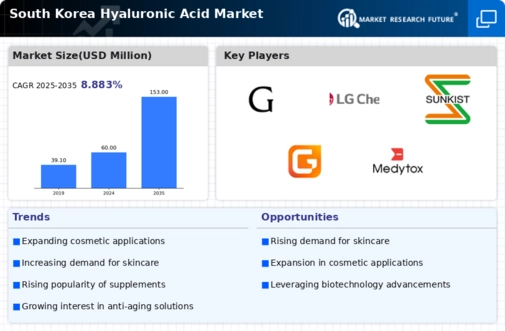Influence of K-Beauty Trends
The influence of K-beauty trends significantly shapes the hyaluronic acid market in South Korea. The global fascination with Korean skincare routines has led to an increased demand for innovative and effective products, many of which feature hyaluronic acid as a key ingredient. K-beauty emphasizes hydration and skin health, aligning perfectly with the properties of hyaluronic acid. As South Korean brands continue to innovate and expand their product lines, the hyaluronic acid market is likely to see substantial growth. The K-beauty phenomenon not only boosts local sales but also enhances the export potential of hyaluronic acid-infused products, indicating a promising future for the market.
Growing Awareness of Skin Health
The increasing awareness of skin health among consumers in South Korea is driving the hyaluronic acid market. As individuals become more informed about the benefits of skincare ingredients, the demand for products containing hyaluronic acid is likely to rise. This compound is known for its ability to retain moisture, making it a popular choice in moisturizers and serums. According to recent data, the skincare segment in South Korea is projected to grow at a CAGR of 8.5% from 2025 to 2030, indicating a robust market for hyaluronic acid. The emphasis on hydration and anti-aging properties further propels the interest in this ingredient, suggesting a sustained growth trajectory for the hyaluronic acid market in the coming years.
Rising Popularity of Anti-Aging Products
The rising popularity of anti-aging products in South Korea drives the hyaluronic acid market. As the population ages, there is a growing demand for products that can effectively combat signs of aging, such as fine lines and wrinkles. Hyaluronic acid is renowned for its ability to plump and hydrate the skin, making it a sought-after ingredient in anti-aging formulations. Market data indicates that the anti-aging skincare segment is expected to reach $1.5 billion by 2026, with hyaluronic acid being a prominent component. This trend suggests that the hyaluronic acid market will continue to thrive as consumers prioritize youthful skin and invest in effective anti-aging solutions.
Technological Advancements in Formulations
Technological advancements in the formulation of skincare products are significantly impacting the hyaluronic acid market. Innovations in delivery systems and product formulations enhance the efficacy of hyaluronic acid, making it more appealing to consumers. For instance, the development of microencapsulation techniques allows for better absorption and longer-lasting hydration. This trend is particularly relevant in South Korea, where consumers are increasingly seeking high-performance products. The market for advanced skincare formulations is expected to expand, with hyaluronic acid as a crucial component. As a result, the hyaluronic acid market is likely to benefit from these technological improvements, potentially leading to increased sales and market penetration.
Increased Investment in Research and Development
Increased investment in research and development within the skincare industry is a notable driver for the hyaluronic acid market. South Korean companies are focusing on developing new formulations and applications for hyaluronic acid, aiming to enhance its effectiveness and broaden its usage. This commitment to R&D is evident in the growing number of patents filed for innovative hyaluronic acid products. As companies strive to meet consumer demands for high-quality and multifunctional skincare solutions, the hyaluronic acid market is expected to benefit from these advancements. The emphasis on scientific research may lead to the introduction of novel products, further solidifying the market's position in the competitive skincare landscape.
















Leave a Comment